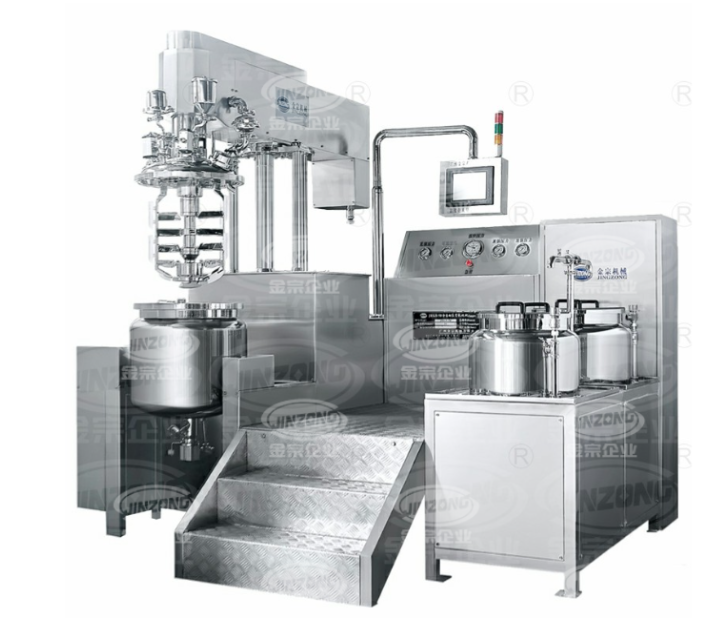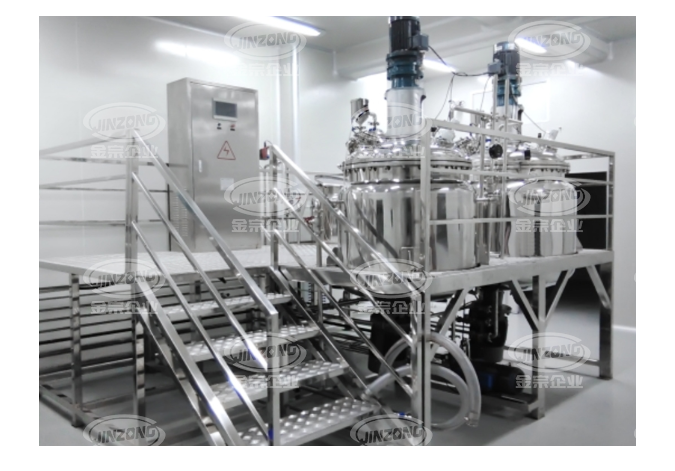Do you know the difference between homogenizers, mixers, and emulsifiers? What kind of machines will food processing factories and pharmaceutical factories use? What kind of equipment will the cake room choose? What are the advantages and disadvantages of each of the three machines? Jinzong Enterprise, with over 20 years of experience in the production, manufacturing, and research and development of homogenizers, mixers, and emulsifying machines, is here to share everyone.
The biggest difference among homogenizers, mixers, and emulsifiers is their different rotational speeds. The homogenizer mainly crushes the large molecular particles inside the material to become smaller, making it a stable dispersion system. It can be used as a precision machining machine, paired with mixers, emulsifiers, and other equipment. And mixers are mainly used for uniform mixing of materials, promoting dissolution, gas absorption, and strengthening heat exchange, which are often used in food processing. Emulsifying machine, through the high-speed rotation of the homogenizing head connected to the engine, cuts, disperses, and impacts materials. The material produced in this way will become more delicate, promoting the fusion of oil and water.

一�、 The Basic Structure is Different:
1. Homogenizer: Pressure driven end (high-pressure pump) and homogenization end (usually homogenization valve or adjustable aperture chamber). The key to high-pressure homogenizer technology lies in the reasonable application and control of high-pressure pumps and homogenization valves/holes.
2. Mixer: The commonly used vertical mixer mainly consists of: motor wheel, motor, barrel body, screw, discharge port, cleaning port, belt pulley, window, ladder, inlet, electrical box, circulating discharge port, feeding port, and other structures.
3. Emulsifying machine: The emulsifying machine mainly consists of: emulsifying tank (adjustable tank cover, flipping tank body), water phase tank, oil phase tank, vacuum system, heating and temperature control system, and electrical control system.
二、 The Working Principle is Different:
1. Homogenizer: Through the precise matching of the rotor and stator, the rotor rotates at high speed and smoothly, forming high-frequency and strong tangential and angular velocities to achieve homogenization.
2. Mixer: The working principle is to rely on the high-speed rotation of the blade at the bottom of the mixing cup to repeatedly crush food under the action of water flow.
3. Emulsifier: Through the high-speed rotation of the homogenizing head connected to the engine, the material is sheared, dispersed, and impacted. This way, the material will become more delicate.

三�����、 Different Application Fields:
1. Homogenizer: Lotion or suspension will shear, impact and cavitate through the homogenizer valve under high pressure. When the sample passes through the homogenization valve under high pressure, the sample accelerates and converts potential energy under pressure, resulting in shear effects, impact effects, and hole effects. It is generally used in tissue dispersion in the field of biotechnology, sample preparation in the pharmaceutical field, enzyme treatment in the food industry, and other fields.
2. Mixer: A small machine commonly used in households to mix various fruits and vegetables, thereby extracting fresh and delicious fruit and vegetable juices.
3. Emulsifying machine: It is widely used in industries such as adhesives, paint coatings, cosmetics, food, pharmaceuticals, plastic resins, printing and dyeing, ink, asphalt, etc.

四�����、 Advantages and Limitations:
1.The advantages of a homogenizer are good mixing effect, but the disadvantages are also obvious. It has high power consumption, low output, is prone to malfunctions, high maintenance costs, and is difficult to clean.
2. The mixer is easy to operate, but it does not have a shearing and refining effect on the material, and can only perform simple mixing. Therefore, if there is a high requirement for particle size, the mixer cannot operate alone.
3.The advantage of an emulsifier is its good mixing effect and wide application. The disadvantage is low yield and poor mixing effect on hard particle materials and high viscosity materials.
The above is a multidimensional comparison of the structure, principle, application, advantages and disadvantages of homogenizers, mixers, and emulsifying machines. We hope it can be helpful to you.
Jinzong Enterprise has been focusing on the design and manufacturing of food and pharmaceutical machinery and equipment, research and development of intelligent control systems, engineering design and installation for more than 20 years. It has a design and marketing service center in Guangzhou and two production factories in Zhaoqing National High tech Zone. It has the qualifications for special equipment pressure vessel manufacturing and pressure pipeline installation (GC2). It is a national high-tech enterprise, a provincial-level specialized and innovative enterprise, with two provincial-level famous brand products, dozens of product patents, software copyrights, and provincial-level high-tech products. It has passed the national intellectual property standard certification, ISO9001-2015 international quality system certification, and EU CE certification, and has been rated as a "Guangdong Province Contract abiding and Creditworthy Enterprise" by the Guangdong Provincial Administration for Industry and Commerce for many consecutive years. Its users are distributed in more than 50 countries and regions around the world. Received widespread recognition and support from over 2000 enterprises of all sizes at home and abroad.
To do a good job, one must first sharpen their tools. Jinzong Enterprise upholds the concept of "quality is like gold, craftsmanship is the core", and provides advanced and automated production lines to manufacturing factories. Friends from home and abroad are welcome to visit and guide us!





